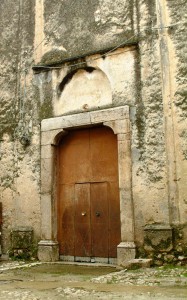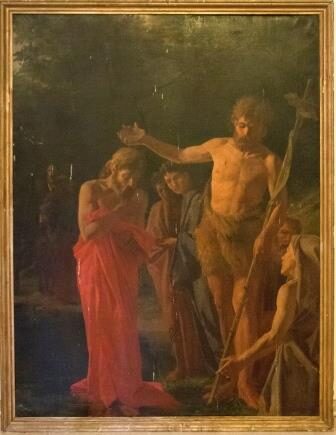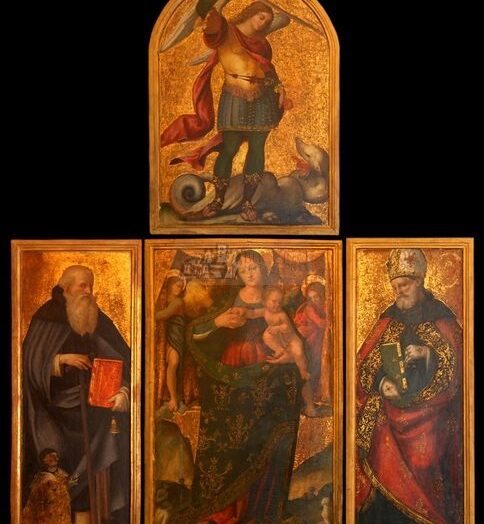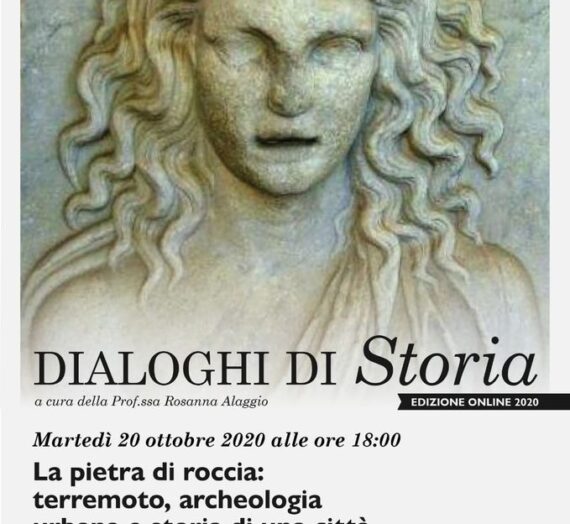1. The restoration of the church of 1872

(Photo by Emanuele Catone)
Between 1870 e il 1871 the church of S. Giovanni Gerosolimitano she was struck by lightning, which caused considerable damage.
From a structural point of view, indeed, the bell tower was destroyed and both the eastern wall and the church floor were deeply damaged. The damage was also remarkable from an architectural and artistic point of view: the main altar suffered a series of damages, the tabernacle was destroyed and even the ancient painting above the altar was irreparably ruined.
The municipal administration, led by Pasquale Bosco, intervened urgently to insure the factories of the Church from further ruin and took action at the Ministry of Grace and Justice to ask for the funding necessary to carry out the repair. The 14 June 1871, indeed, the Ministry approved the expenses made and invited the prefect to have the state of the Church examined by the Civil Engineer and to have an expert report drawn up strictly necessary to restore those factories in good condition1. The site visit to Buccino made it possible to understand the extent of the damage. The technicians report explained that:
The damage caused by lightning is the fall of three-storey walls of the tower of the petiole Campanile and covertura of the same, currently remaining the only height of the first base, with the simple revolt of the southeast wall of two upper floors. The falling material is the product of the faults at the next portion of the church's roof, and destroyed the other small lateral roof on the contiguous passage to the Sacristy, with the degradation of a portion of the top of its supporting eaves wall. Another hole is observed through the wall in correspondence with the picture on the high altar, also produced by lightning, reducing the canvas painting with the effigy of the Holy titular of the Church of no use and useless, having (…) the subjected marble case was shattered, with the gilded copper case contained in it. Other faults can also be seen on the canteen, are also forts, on the predella and in general on the stucco of the main altar itself.
The Civil Engineer the 29 July 1871 he prepared the project of the works necessary for the church, which included an expense of 2350 read, in which in addition to those for repairing damage caused by lightning, some indispensable works were also planned to relieve the church "from that state of narrow-mindedness and abandonment" in which it was located and which was indecent for its sacred destination. The technicians pointed out that:
The church (…), in addition to the damage caused by lightning, it is observed in a state unsuitable for its office, for the deterioration of the ancient glazed windows, and in several degraded points the surface works. Factories in general look pretty good, and in a state of satisfactory solidity. As well as the roof roof overhangs are good, except for partial replacements [that] occur in covertura clay.
The works of utmost urgency concerned the bell tower, which was rebuilt in local limestone on three floors, instead of the original four levels, and surmounted by a domed roof. The wooden staircase to access it was also repaired:
Factory with local limestone and mortar, for the construction of two-storey walls of the aforementioned bell tower (…) which for the economy of spending and solidity while remaining (…) three floors from the ancient which formed four.
The fall of the bell tower rubble had caused damage to the nearest part of the church roof and destroyed the small portion of the roof that covered the adjoining passage that led to the sacristy. It was necessary to rebuild part of the structures and replace most of the roof tiles. The dividing wall was also rebuilt with the neighboring property of Evangelista Chiariello which had been destroyed by the collapse.
A series of renovations were also needed inside the church where the lightning had caused holes in the masonry and damage to the plaster in several places. The frames and plates of the church windows and the four windows of the sacristy were replaced and the walls of the church were whitewashed with lime milk. A series of patches were also made to the ceiling canvas, also ruined in several places, referring also to the chiaroscuro frame.
About the damage caused to the high altar, was shattered there marble case of the tabernacle, with the gilded copper case contained in it; other damages related to the canteen, and gardens, the predella and the stucco of the altar. The stucco patches were made painting them all marble in various colors; the canteen was made new of fine hammered limestone together with its supporting pillars also redone in limestone, similarly worked with grooving; even the steps and the predella were reworked.
One of the holes produced by lightning unfortunately rendered of no use and useless also the ancient canvas painting depicting Saint John placed on the main altar, which it was decided to replace with a new work.
According to the specifications, the artist to whom the work was commissioned was reported by the Civil Engineer and was approved by the contractor who should have paid for the work. The new framework, for which an expense of 340 read, was therefore commissioned to the Salerno painter and decorator Gaetano D'Agostino2. So in fact Ferdinando Primicerio, chief engineer of Civil Engineering, the 17 July 1872 congratulated col historical painter Salerno for accepting the assignment:
With immense pleasure this Office has learned that Your Illustrious Lordship has accepted the commission of the Oil Painting on canvas of m. 2,10 per m. 1,60 representing the Baptism of Jesus Christ, to be allocated to the High Altar of the Parish Church of S. Giovanni in Buccino of Royal Patronage, and you are certain that you have one of those works that your Lordship usually does, without minding the tenuity of the price, but only by being guided by the love of art, from which it is so invaded. As soon as the amount of the 1st Certificate transmitted on the date will be issued to the Contractor Mr Quaranta Pasquale 8 because of restoration work already carried out in the Church itself, Your Lordship will have a deposit of £ One Hundred and Fifty, and the majority in two hundred will receive from the same Contractor when the work is finished, and following the Final Measure of all the works carried out in said Church, and debt test certificate. She will now be able to help the work itself with that energy that distinguishes it so much, so much so that it will have to be delivered on the fifteenth day of September, if you do not seriously want to compromise the interests of it Contractor, who must, however, take to heart. I am sure of your cooperation in this regard, and in his time I expect a kind invitation from her to admire the work itself.
The contractor Quaranta il 30 October 1872 he paid to the Salerno painter 350 lire for the painting e 32 lire for the value of the golden frame.
The "Baptism of Jesus", signed and dated by D'Agostino, remained in the church of San Giovanni gerosolimitano until its closure following the damage caused by the earthquake of 19803. For security reasons it is now kept in the Mother Church.


(Photo by Olga Annunziata)
The works dictated not by the damage caused by the accident but by the need for decoration of the church instead concerned the floor. L’ancient pavement it was in fact demolished equally of the ancient and degraded beaten brecciame existing and replaced by a brick floor made with brick pavement of the factories of Ricigliano with a new support base; the plaster was then redone in the whole area where the new floor connected to the walls of the church. On this occasion, the bones still existing in the burials under the church were extracted and deposited to the elements in an uncovered room placed next to the sacristy.
For reasons of opportunity and economy, it was decided to entrust the restoration work to private negotiation. Initially, the contractor was identified as Onofrio Chiariello from Buccino, reported by the mayor who was guarantor of the civil engineering of his abilities. Due to an illness that affected Chiariello, the works were then entrusted to piperniere Pasquale Quaranta, also from Buccinese.
The works were approved by the competent ministry in March 1872 and the engineer Giovanni di Torrebruna, assistant for the construction of the 3rd section of the National Road n. 36 ter and delegate of the Civil Engineer, officially delivered them on 21 May 1872.
In reality, the work at that time had already started some time ago because the contractor did not want to risk delivering the work late. The tender specifications, indeed, provided that the work should be completed without delay 40 days from delivery and that the contractor had to pay ten lire for each day of delay in their conclusion. Upon delivery of the works, in fact, the bell tower was already finished, whose dome had been coated externally not with enamel, as expected in the project, but with the tiles because the enamel, being frequent here the frosts, it would crack immediately. The project involved its reconstruction starting from the first floor but Quaranta independently decided to rebuild the ground floor as he thought it was in a very bad state and with several injuries; the Civil Engineer, however, considered this work superfluous and charged it to the builder. Likewise the Civil Engineer, highlighting that following one's whims without superior authorization often leads to these painful consequences, he expressed his disappointment at Quaranta's decision to divide the church floor in four parts with two lists of basoli (…) on the cross, for since it was large enough it could not perform well and since the work had already been completed he arranged that all the basoli are all of work worked in the fine hammer surface, squared and sighted (…) so as to form a single level with the four portions of beaten in mortar.
In the end the works had a cost of 2115,25 read, with savings of 234,75 lire compared to what was budgeted. The contractor Quaranta had the down payment of 1200 lire in July 1872 and the rest 915,25 residual after the preparation of the final status of the works and their testing, occurred on 18 October 1872.
In the following decades the church was subject to further restoration. For the interest of the parish priest don Antonio Grieco the canopy and ceiling were rebuilt - on which the Buccinese painter Michele Volpe painted the figure of Saint John the Baptist on canvas - and the sacristy and the rectory were rebuilt. At the expense of the parish priest, both the high altar and marble were built, replacement of the existing one, is the one dedicated to S. Antonio of Padua4.
.

The bell tower suffered serious damage following the Allied bombing that in 1943 hit the area near the church, and then again of the earthquake of 1980 which caused its serious failure. Currently it needs an urgent safety intervention, since its tightness is guaranteed only by an emergency intervention carried out in the days immediately following the earthquake.
I thank Angelo Murano, Antonella Branda and Olga Annunziata for allowing me to use the photos.
EMANUELE CATONE
Note
- The related documentation, from which the news and quotes reported in the article are drawn, is in State Archive of Salerno, Civil engineering, b. 208/116.
- M. Bignardi (the care of), Gaetano D'Agostino. Paintings and drawings, Salerno 2002.
- Cf.. O. Annunziata, Historic-urbanistic profile of Buccino, thesis in Architecture, University of Naples, Academic year 2001-2002, fig. 201, from which the photos of the painting are taken.
- E. Grieco, Buccino - Antica Volcei. History, art, traditions, morals, Salerno 1959, p. 65. E. Catone, The cabreo of the gerosolimitana commenda of S. Giovanni di Buccino, thesis in Archivistics, University of Naples, academic year 2009-2010, pp. 86-87.




